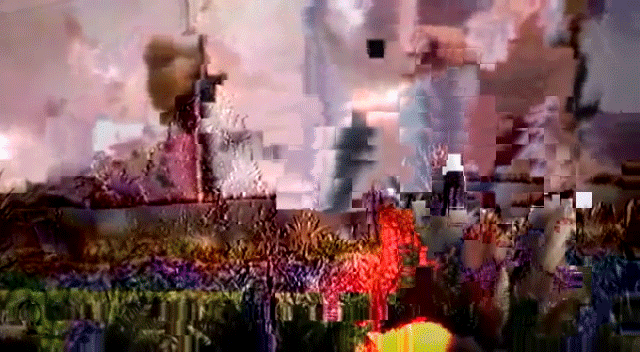User:Sara/
Language
“ […] A digital image that can be seen cannot be merely exhibited or copied but always only staged or performed. Here, an image begins to function like a piece of music, whose score, as is generally known, is not identical to the piece - the score being not audible, but silent. For the music to resound, it has to be performed. To perform something, however, means to interpret it, betray it, destroy it. Every performance is an interpretation and every interpretation is a misuse. "
__ Boris Groys, Religion in the Age of Digital Reproduction (e-flux, 2009)
In his 2003 book In the Break, Fred moten starts by stating that objects can and do resist. But what is an object in the age of digital reproduction? "It may seem obvious”, Mitchel Resnick and Brian Silverman write in their 1996 essay Exploring Emergence*, as an object composed of four white squares moves on the black canvas of the side screen:
“ … in fact, what appears to be an object is not really an object at all. All that is happenning is that little squares on the screen are turning “on” and “off”, following a set of simple rules. And those rules say nothing at all about objects …"
This simple example reminds us that objects are nothing but a set of abstractions performed by commands and rules that flow in a ritual of endless transformations between the written, the seen, and the spoken. If photography teaches us something about the visual representation of the real, then digital images teach us about the abstraction of the real into an act of language.
- http://www.playfulinvention.com/emergence/index.html
Hypervisibility (the what?)
On the 29th of June 2014, the Islamic State of Iraq and Sham (ISIS) released the very first recording online claiming an all-embracing Muslim Caliphate. The general sentiments accompanying this first declaration (at least for us living within the frontiers of the so-called Middle-East) were disbelief, then horror, then a surprising and brutal sense of familiarity. As ISIS started to publish their videos online after the break of the Syrian revolution in 2011, it seemed impossible to miss the endless references to western popular aesthetics and digital platforms to emphasize the Islamic State's role in the global political imaginary.
The horrifying images that surfaced on the Internet after the declaration of the formation of the state drew my attention to the ease with which such scenes are iterated. The shocking casualeness of the online circulation of the images of a ravaged body seemed to turn suffering into a benumbing spectacle.
In today’s dense inforsphere, we are surrounded by an overload of images and the faster they circulate the more difficult it becomes to seize them or comprehend them. According to Saidiya Hartman, it is this hypervisibility that problematizes the precariousness of empathy: the feelings that consume us vis-à-vis the images of horror are either indifference or a narcissistic identification with the (humanity) of the other.* But then my question is, where does the horror come from? Does it only reside in the act of killing? Or does it manifest itself in our failure to extract meaning from the digital hypercomplexity we are surrounded with?
In my project, I would like to address this question by interacting with digital images outside of the realm of the visual, outside the limitations of meaning and perhaps even beyond language. I would like to treat digital images as noise; as undefined utterences that are constituted beyond the finite capacity of human comprehension.
Noise (the how)
So how to make noise?
In order to answer this question, we must first contemplate what is sound and what is listening. In Salomé Voegelin's Listening to Noise and Silence, she states that "listening cannot contemplate the object/phenomenon heard separate from its audition because the object does not precede listening. Despite the differences in the mechanisms of listening and the mechanisms of seeing, it is important for me to stress on the perfomativity of the digital image, to the idea that the image is only visible once it is performed and interpreted from an originally non-visual score. In this inter-operative motion, it is impossible to separate the viewer and the set of interfaces that connect the viewer with the visual scene.
Elements
Relation to previous practice
Last year I took a set of recruitment videos produced by ISIS as my target material for a series of visual experiments. One of the examples involved the extraction of constitutive digital data from the video “Flames of War” and leaving it with hardly indetifiable pixelated explosions. By removing the p-frames of the video, the photographic element was removed, meaning the only element that contained representational information about the image was eliminated. The abstract movement inscribed in the i-frames was all that remained.
I take this example to revisit some of the images I was creating earlier without necessarily understanding why at the time. However, along my search, both my political concerns and my relation to my practice are starting to make sense.
The main reason I went to study audio-visual arts was because I was always interested in sound. My relation to images had always been a complex one. I had hardly ever been to the movies prior to entering film school, but my fascination with films came originally from its aural performance, from the fact that it all melted back down to language, to speech, to the voice. And here I am again, trying to explore this phonic materiality of the visual, and trying to find ways to articulate it and expand on it.
References
- Groys, Boris. Religion in the Age of Digital Reproduction. E-flux, 2009.
- Resnick, Mitchel and Silverman, Brian. Exploring Emergence, 1996
http://www.playfulinvention.com/emergence/index.html
- Moten, Fred. In the Break, University of Minnesota Press, 2003.
- Voegelin, Salomé. Listening to Noise and Silence, continuum, 2010


